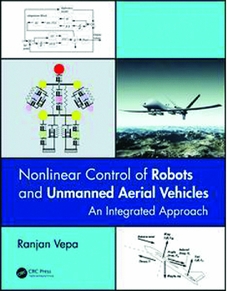
Any engineer or researcher developing control systems for robots and Unmanned Aerial Vehicles (UAVs) is always faced with the problem of identifying, designing and deriving the control system for the platform they wish to deploy. Apart from designing and building the platform, control system development is the next most challenging task for any roboticist. A good understanding of the physical constraints of the platform as well as its operational domain and operational requirements is needed in order to develop an appropriate control system.
In one volume, Vepa has done a very good job of concisely presenting methodologies and theories for realising the control of UAVs and robots. It is written in such a way that is easy to understand and, hence, apply. It is like a toolkit of methodologies and equations to understand various robot platform problems and challenges as well as control theories and approaches one could bring to bear to solve them in various scenarios.
It is also a good book for those who are interested in model-based design of control systems. For example, Chapter Five presents a discussion on model-based and biomimetic methods of control. It also gives an overview of how artificial neural networks could be used as well as a quick and straightforward introduction to fuzzy set, logic and reasoning. The same approach was used in the next couple of chapters (six and seven) where the issue of stability for linear and nonlinear systems are discussed. Furthermore, various control laws are also discussed together with their practical implementation. Examples include sliding mode control, adaptive model-based predictive control, proportional integral derivative control as well as a whole chapter dedicated to system parameter identification.
The way the book is written enables a reader to read each chapter independently thereby making it suited for a quick read to learn a concept or brush up on one's knowledge.
I believe this book will appeal to a wide readership of industrial engineers as well as academics interested in extending the frontiers of control theory of UAVs and robots.


